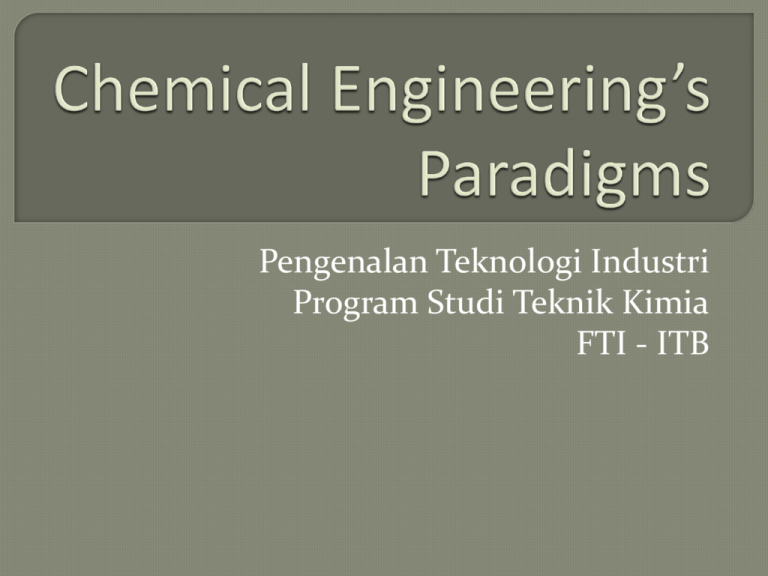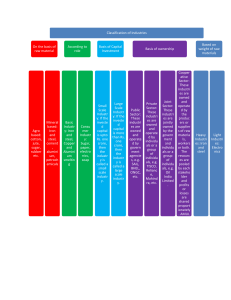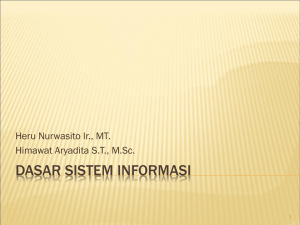A History of Chemical Engineering
advertisement

Pengenalan Teknologi Industri Program Studi Teknik Kimia FTI - ITB Paradigm is a constellation that defines a profession and an intellectual discipline Pengenalan Teknologi Industri 2 0. Pre-paradigm - engineers with no formal education 1. The first paradigm - Unit Operations, 1923 2. The second paradigm - Transport Phenomena, 1960 3. The third paradigm - ? Pengenalan Teknologi Industri 3 Fire (300,000 BC) as the first chemical technology • Led to pyro-technologies: cooking, pottery, metallurgy, glass, reaction engineering Chemical technology as empirical art, with no reliable scientific foundation or formally educated engineers. Ecole des Ponts et Chausee, 1736, first modern engineering school. Pengenalan Teknologi Industri 4 Arthur D. Little, industrialist and chair of visiting committee of chemical engineering at MIT, wrote report in 1908 “Unit Operations should be the foundation of chemical engineering” First textbook Walker-Lewis-McAdams “Principles of Chemical Engineering” 1923 Pengenalan Teknologi Industri 5 Became • core of chemical engineering curriculum: unit operations, stoichiometry, thermodynamics • principle to organize useful knowledge • inspiration for research to fill in the gaps in knowledge Effective in problem solving • graduates have a toolbox to solve processing problems in oil distillation, petrochemical, new polymers Pengenalan Teknologi Industri 6 The "unit operations" concept had been latent in the chemical engineering profession ever since George Davis had organized his original 12 lectures around the topic. But, it was Arthur Little who first recognized the potential of using “Unit Operations" to separate chemical engineering from other professions While mechanical engineers focused on machinery, and industrial chemists concerned themselves with products, and applied chemists studied individual reactions, no one, before chemical engineers, had concentrated upon the underlying processes common to all chemical products, reactions, and machinery. Pengenalan Teknologi Industri 7 Pengenalan Teknologi Industri In transforming matter from inexpensive raw materials to highly desired products, chemical engineers became very familiar with the physical and chemical operations necessary in this metamorphosis. 8 Pengenalan Teknologi Industri 9 Vacuum Dryer Rotary Dryer Pengenalan Teknologi Industri 10 Pengenalan Teknologi Industri 11 Pengenalan Teknologi Industri 12 Pengenalan Teknologi Industri 13 Crystallization tank Pengenalan Teknologi Industri 14 Pengenalan Teknologi Industri 15 Pengenalan Teknologi Industri 16 Pengenalan Teknologi Industri 17 Fluid Catalytic Cracking Pengenalan Teknologi Industri 18 Pengenalan Teknologi Industri 19 Pengenalan Teknologi Industri 20 World War II creation of new technologies by scientists without engineering education: atomic bomb, radar. Engineering students needed to master new concepts and tools in chemistry and physics. Unit Operations no longer created streams of exciting new research problems that were challenging to professors and students, and useful in industry. Pengenalan Teknologi Industri 21 First textbook “Transport Phenomena” by BirdStewart-Lightfoot, 1960, based on kinetic theory of gases Pengenalan Teknologi Industri 22 Textbook by Amundson “Mathematical Methods in Chemical Engineering”, (1966). A new burst of creative research activities. American chemical industry dominated world, DuPont and Exxon content to recruit academically educated graduates, willing to teach them technology. Pengenalan Teknologi Industri 23 The Engineering Science movement became dominant in the US, and was taught at all the leading universities. AIChE accreditation requires differential equations, transport phenomena. Research funding agencies and journals turn their backs on empirical and qualitative research as “old fashioned”. Pengenalan Teknologi Industri 24 Phasing out of formerly successful products: tetra-ethyl lead, DDT, cellophane, freon or CFC. End of the parade of new polymers: celluloid, bakelite, nylon, kevlar. To attract the best students, the lure of new products to enhance lives - laptop computers, cellular phone and internet. Cost-cutting and environmental protection is no match for glamorous new products. We need to give chemical engineers the intellectual toolbox, to innovate exciting new products that people will learn to love. Pengenalan Teknologi Industri 25 Product engineering is innovation and design of useful products that people want. Core of creative engineering: Define a product, study the customers & needs 2. Understand property-structure 3. Design and innovate the product 1. Pengenalan Teknologi Industri 26 Production of Synthetic Ammonia and Fertilizers, Production of petrochemicals, Commercial-scale production of antibiotics (biotechnology/ pharmaceuticals), Establishment of the plastics industry, Establishment of the synthetic fiber industry, Establishment of the synthetic rubber industry, Electrolytic production of Aluminum, Energy production and the development of new sources of energy, Pengenalan Teknologi Industri 27 Production of fissionable isotopes, Production of IT products (storage devices, microelectronics, ultraclean environment), Artificial organs and biomedical devices, Food processing, Process Simulation tools, Environmental control, Membrane technology, New material based on nano technology. Pengenalan Teknologi Industri 28 Pengenalan Teknologi Industri 29



